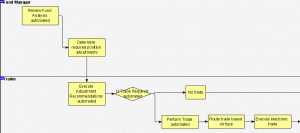 I am often asked “What’s the difference between workflow and BPM? Are they not the same thing?”
I am often asked “What’s the difference between workflow and BPM? Are they not the same thing?”
Vendors typically offer either workflow or Business Process Management software. Some larger software vendors offer both. Workflow is standard functionality included in many Enterprise Content Management (ECM) software systems. Once you understand workflow you’ll understand why.
A Business Process Management suite of tools (BPMS) is an alternative to workflow. A BPMS can be used in lieu of workflow where additional functionality is required. It’s important to understand how these two products differ.
What is Workflow?
Unstructured content, better known as an electronic image of paper document, has a specific lifecycle within a business. In this case we define a “lifecycle” as the period of time a piece of content is useful to a business operation. An example of unstructured content might be the electronic image of a purchase order. A purchase order is a common document used by many businesses.
Electronic document images flow between the various workers of a business. The workers need to reference the document images to accomplish their work. Workflow is nothing more than the work tasks a piece of content is involved in over its life-cycle.
Let’s use as an example a purchase order scenario. If we follow the steps a purchase order takes throughout its lifecycle we can understand what “workflow” is. Imagine a company needs to replenish their stock of office supplies. They send a purchase order to an office supply vendor for the supplies they require. The office supply vendor receives the customer’s order. The office supply vendor’s subsequent processing of the order is an example of a workflow.
Once received and prepared, the purchase order is scanned to create an electronic image of it. This is where the purchase order document workflow begins. After the image is created it is sent to the order entry clerk’s work queue of orders to be processed. The clerk views the purchase order image. From the image the clerk enters the products and quantities into an order processing application. The application forwards the order and the supporting purchase order image to the warehouse for fulfillment.
purchase order document workflow begins. After the image is created it is sent to the order entry clerk’s work queue of orders to be processed. The clerk views the purchase order image. From the image the clerk enters the products and quantities into an order processing application. The application forwards the order and the supporting purchase order image to the warehouse for fulfillment.
The entered order and purchase order image are routed to the work queue of a warehouse clerk. The clerk will have the items on the order picked from warehouse stock. Once collected the office products are packaged by a shipping clerk to be sent to the customer.
Using the order management application the shipping clerk manually confirms the order has been completed and it is ready for shipment. As one last check the clerk views the packaged order and compares it to the products listed on the image of the original purchase order.
The next step in the workflow is the shipping clerk releasing the package for shipment. The shipping clerk then forwards the order along with the purchase order image to the billing department. The billing department generates an invoice which will be sent to the customer.
The billing clerk electronically marks the order as completed and archives the purchase order image in an electronic folder. This is the final step of our purchase order workflow example. Our example shows workflow as the automation of paper flowing through a process. Instead of moving paper physically, we’re moving images of that paper electronically through a sequence of work tasks. Now let’s look at Business Process Management.
What is Business Process Management?
Business Process Management (BPM) is a business discipline. It encompasses a methodology which is used to continuously optimize the way a business operates. To satisfy comprehensive BPM requirements a suite of integrated business process tools (a BPMS) is required. A BPMS enables the understanding, management and optimization of business processes. Let’s again use our purchase order example but this time let’s put it in the context of BPM.
The objective of workflow is to replace the physical movement of documents with the electronic movement of documents in a pre defined sequence. The objective of BPM is overall business management and optimization using process centric technology.
BPM starts with the quantitative analysis of existing business processes. This type of process analysis is referred to as Business Process Analysis (BPA). To perform BPA you first need to establish a baseline of characteristics for your existing processes. The baseline is established by discovering in depth details of the current state of the business processes.
 This current state, referred to by business analysts as the “AS IS”, is discovered by the business analyst interviewing various subject matter experts who are responsible for specific business processes.
This current state, referred to by business analysts as the “AS IS”, is discovered by the business analyst interviewing various subject matter experts who are responsible for specific business processes.
With the “AS IS” discovered the next step is to develop an improved future state process design. The future state design is referred to as the “TO BE”. The end goal of the business analyst is to evolve the AS IS to a TO BE design using various optimization techniques.
Identifying issues and opportunities for improvement within the existing process is often a goal of the business analyst throughout their interviews with the subject matter experts. By understanding the properties of the AS IS process along with capturing any issues or opportunities for improvement, the business analyst will gain an understanding of what process design changes are required..
Another goal of the business analyst is to substantiate any process design changes by performing a gap analysis. The gap analysis compares the AS IS with the TO BE process model. A quantitative gap analysis involves process properties. Common properties used in a gap analysis are cycle time and process costs.
Let’s assume using our purchase order example the office supply vendor has completed their discovery of the order entry AS IS process. Then they performed a gap analysis of the AS IS versus the TO BE process designs. Their analysis determined the order entry process can be streamlined by eliminating two unnecessary activities, by doing another two activities in parallel and by fully automating three manual activities.
Before the business analyst gives the TO BE process design requirements to the development group for implementation, the business analyst might perform simulations of the TO BE design. Simulations might be run to determine how the new process design will react to increases in the order volume. Using a variety of “what if” scenarios the TO BE order entry process design is proven out as an optimum new process design. The development group then creates a new order entry application from the business analyst’s TO BE process design.
Now, when the office supply vendor receives a purchase order it is immediately scanned and specific information is automatically recognized and extracted from the paper document. Once extracted the data is used to validate customer information on the purchase order directly with information from a Customer Relationship Management (CRM) application.
Based on the TO BE order entry process, if the purchase order is from a new customer the customer information will be automatically added to the CRM database. This newly automated step was proven during analysis to save not only time but also money. Another aspect of the TO BE design is that the office supply vendor can now accept orders directly from their web site.
Product information on the purchase order is automatically recognized and extracted and input directly to the order management application. The order is validated for completeness and correctness now in a fully automated manner. If the order passes all checks an electronic message is generated for the items being ordered to be picked from warehouse stock. Once picked the products are packaged and shipped to the customer.
order management application. The order is validated for completeness and correctness now in a fully automated manner. If the order passes all checks an electronic message is generated for the items being ordered to be picked from warehouse stock. Once picked the products are packaged and shipped to the customer.
An invoice is automatically generated and delivered electronically to the customer who placed the order as soon as the order is shipped. The customer also receives an email with a delivery status.
Using BPMS our office supply vendor will also implement monitoring of their new order entry process. They can closely manage the cycle time of their process from order receipt to shipment. They implement Business Activity Monitoring (BAM) to instrument their new order entry application.
Using BPM the office supply vendor has the ability to re-analyze their order entry process model anytime their business environment changes. Now instead of analyzing process metrics gained during interviews, process analysis will be based on metrics measured during process execution. This is why a truly integrated BPMS is important.
An integrated BPMS ensures any re-analysis will be based on real world execution statistics. Execution data is collected during the monitoring (BAM) of the order entry application.
Conclusion
BPM is understandably mistaken as workflow and visa versa. Typically companies start with the implementation of an Enterprise Content Management (ECM) system. The goal of which is to reduce their overall use of paper documents. A subsequent phase of an ECM implementation is to replace the physical movement of documents with an electronic orchestration of document images. This is workflow.
BPM provides more than electronic document movement. BPM is a technology-based approach for understanding, managing, and optimizing business processes. Some companies that start with workflow graduate to BPM. Some start with BPM. What did you do?
Jim Thomson – The Guisado Group
jim@guisado.com



